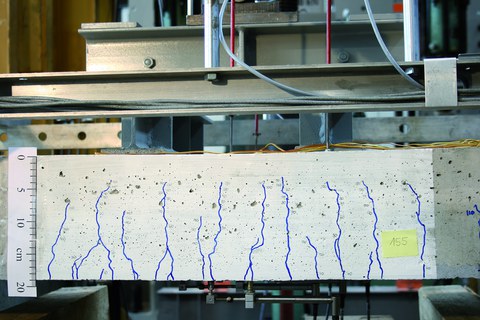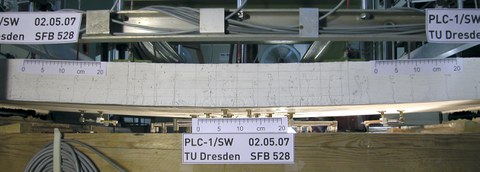SFB 528-T6: Bemessungsmodell und Applikationstechnologie für Biegeverstärkung von Stahlbetonplatten
Inhaltsverzeichnis
Projektdaten
|
Titel | Title |
Bericht aus dem Jahrbuch 2011
Biegeverstärkung von Platten

Rissbild einer zweilagig verstärkten Stahlbetonplatte
Im Transferprojekt T6 des Sonderforschungsbereiches 528 wurden weiterführende Untersuchungen an textilbetonverstärkten Stahlbetonbauteilen durchgeführt. Besonderes Augenmerk galt dem in einem früheren Teilprojekt entwickelten Rechen- und Bemessungsverfahren zur Bestimmung der erforderlichen textilen Bewehrungsfläche für die Biegeverstärkung von Platten und Balken für den Versagensfall des Biegezugversagens. Dieses Modell basiert auf einer Erweiterung der standardmäßigen Biegebemessung im Stahlbetonbau. Erstmals wurde die Anwendbarkeit des Verfahrens auf zu verstärkende Stahlbetonquerschnitte mit einer Vielzahl veränderlicher Parameter, wie Bauteildicke, statische Nutzhöhe, Stahlbewehrungsgrad und Bewehrungsdurchmesser, und unter Anwendung eines in den vergangenen Jahren neu entwickelten Carbontextils mit 800 tex Garnfeinheit und einem Rovingabstand von 7,2 × 18,0 mm überprüft. Im Otto-Mohr-Laboratorium wurden dazu 15 kleinformatige Platten mit einer Grundfläche von 1,80 × 0,60 m und Dicken von 10 oder 18 cm im Biegeversuch bis zum Bruch getestet.
Vor Beginn der Testreihe waren zehn der 15 Platten ein-, zwei- oder dreilagig verstärkt worden. Die Textillagen wurden im Laminierverfahren und unter Anwendung eines Feinbetons im Spritzverfahren auf die zu verstärkende Oberfläche aufgebracht. Die nötige Maschinentechnik, Arbeitsabläufe und Vor- und Nachbehandlungsmaßnahmen wurden entwickelt. Vor allem die von der Firma Pagel Spezial-Beton GmbH konzipierte Feinbetontrockenmischung ist einfach zu handhaben, was eine schnelle und wirtschaftliche Ausführung der Spritzbetonarbeiten ermöglicht.
Die experimentellen Betrachtungen führten zu dem Ergebnis, dass das aufgestellte Rechenverfahren als geeignet beurteilt und für die Bemessung empfohlen werden kann. Ein weiteres Ziel des Transferprojektes war die Entwicklung von praxistauglichen, einfach zu handhabenden Bemessungstabellen. In Anlehnung an die bekannten Bemessungstafeln des Stahlbetonbaus wurden die dazu notwendigen mathematischen Grundlagen erarbeitet. Die Bemessungstabellen werden gegenwärtig noch verfeinert.
Bericht aus dem Jahrbuch 2009
Biegeverstärkung von Platten

Stahlbetonplatte verstärkt mit Textilbeton unter Biegung
In diesem Projekt stehen zum Einen das Aufstellen eines für den Planungsingenieur handhabbaren Bemessungskonzeptes und zum Anderen die Erarbeitung eines wirtschaftlichen Applikationsverfahrens im Mittelpunkt.
Bemessungsverfahren
Anhand experimenteller Untersuchungen wurde nachgewiesen, dass mit Verstärkungsschichten in der Zugzone von Stahlbetonplatten deren Biegetragfähigkeit signifikant gesteigert werden kann. Je nach Eigenschaft des verwendeten Textils und des Altbetonbauteils konnte die Tragfähigkeit um mehr als den Faktor zwei erhöht werden. Neben der Erhöhung der Tragfähigkeit wirkt sich die Verstärkung auch positiv auf die Gebrauchstauglichkeit aus. Die verstärkten Bauteile verbleiben länger im ungerissenen Zustand I. Während und nach der Rissbildung wurde im Vergleich zum unverstärkten Referenzbauteil eine Verringerung der Rissbreiten und -abstände festgestellt. Die Rissbreite im Altbeton wurde etwa halbiert.
Das vorhandene entwickelte Bemessungsverfahren basiert auf einer erweiterten Standard-Stahlbeton Biegebemessung. Ziel ist die Beschreibung des Zusammenwirkens der Stahlbewehrung und der textilen Bewehrung unter Berücksichtigung der unterschiedlichen Verbundeigenschaften. Es soll ein vereinfachtes Bemessungsverfahren entwickelt werden, in dem das jeweilige Verbundverhalten vereinfachend durch einen geeigneten Verbundbeiwert berücksichtigt wird. Für eine zutreffende Beschreibung des inneren Kräftegleichgewichts werden die Verbundeigenschaften der Textilien ermittelt und in das Bemessungsmodell implementiert.
Applikationstechnologie
Die Definition eines geeigneten Verfahrens für das Verstärken großflächiger Bereiche ist für Praxisanwendungen von zentraler Bedeutung. Durch Großversuche an vertikalen, schrägen und horizontalen Flächen (von oben und über-Kopf) wurde ein optimierter Arbeitsablauf durch aufeinander abgestimmtes Spritzen des Feinbetons und Einlaminieren des Geleges aufgestellt. Dabei standen Fragestellungen u. a. zur Gelegekonfektionierung, Maschinentechnik sowie zur Vor- und Nachbehandlung im Vordergrund. Für das Verstärkungsverfahren ergaben sich folgende Schwerpunkte:
- Nassspritzverfahren mit Förderart-Dichtstrom;
- Oberflächevorbehandlung mittels Sandstrahlen (Rauheit mind. rau) und 24 h Vornässen;
- Spritzdruck mit geringem Rückprallverhalten (Druckluft > 5 bar, > 5 m³/min);
- Mischregime mit stufenweiser Wasserzugabe und Mischdauer länger 5 min;
- Beginn der Nachbehandlung erforderlich eine Stunde nach Verstärkungsende.
Ein weiterer Schwerpunkt war die Entwicklung einer Trockenmischung für den Feinbeton, welcher hohe Anforderungen an Frischbetonkonsistenz, Maschinenverarbeitbarkeit sowie Festbetoneigenschaften erfüllen soll.
